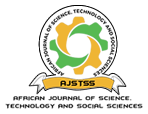Evaluation of the effect of different types of stabilizers and salt on improving the physico-chemical properties of camel milk yoghurt
DOI:
https://doi.org/10.58506/ajstss.v1i1.29Keywords:
Camel milk, Climate change, Camel milk yoghurt, Stabilizers, ViscosityAbstract
Camel milk is recognised for its nutritional and medicinal properties. Camels are very resilient can also withstand harsh and hot climatic conditions and produce milk over a long period of time when other livestock succumb. Converting camel milk into yoghurt can increase milk shelf-life ensuring its available during drought enhancing food security. However, processing of camel milk yoghurt is challenging due to weak coagulum which has unacceptably low viscosity. The objective of this study was to evaluate the effect of different stabilisers and salt on viscosity, titratable acidity, pH, water holding capacity and syneresis of camel milk yoghurt. Camel milk was obtained from Anolei women group, Isiolo County and transported to Food Science Laboratories in Meru University of Science and Technology. The milk was assessed for quality through platform tests. Effect of two stabilisers (starch and modified starch) and a salt on yoghurt properties were evaluated. The stabilisers were added in the range of 2- 3% while salt concentration was 0.075%. The fermentation was carried out under controlled conditions in a cheese vat. After fermentation, yoghurt was analysed for the viscosity, water holding capacity, susceptibility to syneresis, tritratable acidity and change in pH over six hours during fermentation and after 7, 14 and 21 days during storage under refrigeration. The pH of yoghurt with modified starch decreased with fermentation period (1-6 hrs) from 5.8 ± 0.2 to 4.3 ± 0.2, while for yoghurt containing starch decreased from 5.8 – 4.0. The water holding capacity increased with increasing stabiliser concentration from 2-3%. The susceptibility to syneresis decreased with increasing stabiliser concentration but increased over the storage period. The viscosity increased with increasing the stabilisers concentration from 2 - 3% during fermentation. At a concentration of 3% modified starch and 0.075% salt resulted in highest viscosity (0.173±0.01 Pa.s) which is similar to that of commercial yoghurt. This study shows that it is possible to manufacture camel milk yoghurt by adding modified starch and salt to achieve similar physico-chemical properties to available commercial yoghurts.


